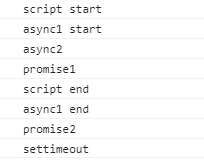JS异步事件顺序:setTimeout,async,promise
为什么最近更新那么频繁,还不是因为笔试的时候瞎了?
先说异步事件执行顺序的规则:
1. 定时器异步队列和promise队列不是同一队列,promise优先级高于setTimeout;
2. 创建promise对象里面的代码属于同步代码,其异步性体现在then和catch处;
3. 遇到await,先执行完await所在行的事件(阻塞到执行完成),然后让出当前线程,继续走同步事件,await后面的语句等同于Promise.resolve(),进入promise的异步队列排队。
好了,理解这些就能做题了
async function async1() { console.log("async1 start"); //2 同步事件 await async2(); //3 执行完后继续走同步事件 console.log("async1 end"); //6 await之后的代码 首选进入promise异步队列 } async function async2() { console.log( 'async2'); //3 }
console.log("script start"); // 1 同步事件! setTimeout(function () { console.log("settimeout"); //8 最后,定时器的异步走最后!!! },0); async1(); //2 走异步函数内部的同步事件 new Promise(function (resolve) { console.log("promise1"); //4 同步事件! resolve(); }).then(function () { console.log("promise2"); //7 最后进入promise异步队列 }); console.log('script end'); //5 同步事件!
加了备注了,但还是上结果吧

注意:await只能存在与 async 定义的函数内部, 遇到await 之后,代码就暂停执行了,必须等await代码执行完成后,才能进入下一步,下一步仍是先走同步代码。
懂了么?如果对 async 还迷糊,那就做以下测试!
上代码认识一下async
async function timeout() { console.log('hello world'); //类似于创建promise对象时的同步代码 return '我属于promise对象' //这才是promise对象返回的resolve对象 } timeout().then((result)=>{ console.log(result) }) console.log('虽然在后面,但是我先执行'); //同步事件
输出结果:

所以:async所定义的异步函数,其返回值是promise对象
async function timeout(flag) { if (flag) { return 'hello world' } else { return 'my god, failure' } } console.log(timeout(true)) // 调用Promise.resolve() 返回promise 对象。 console.log(timeout(false)); // 调用Promise.reject() 返回promise 对象。



